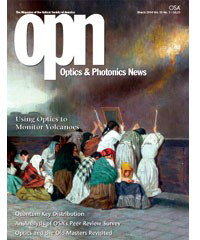
March 2004 Issue
Feature Articles
An Analysis of OSA’s Peer Review Survey
Peer review of scientific articles is considered a fundamental professional responsibility by the majority of those who responded to a survey of reviewers for OSA’s journals.
by John Childs, Kelly Cohen, Mark Dixon and Paul L. KelleyUsing Optics to Monitor Volcanoes
Geochemical reactions and seismic activity lead to changes in the temperature and composition of volcanic gases. Laser spectroscopy enables online, in situ monitoring of volcanoes. In combination with fiber optic sensors, it may one day serve as the basis for a new type of eruption warning system.
by Ulrike Willer, Christian Bohling and Wolfgang SchadeQuantum Key Distribution: How Do We Know It’s Secure?
Quantum key distribution—the creation of secret keys from quantum mechanical correlations—is an example of how physical methods can be used to solve problems in classical information theory. The author describes the basic principles that can be used to confirm the security of the quantum key distribution systems now being marketed to banks, governments and network service providers.
by Norbert LütkenhausOptics and the Old Masters Revisited
Did Jan van Eyck use an optical projector to create one of the most famous paintings of the early Renaissance? Some have suggested that the artist built the projector by reversing the convex mirror depicted in the painting itself. The author arrives at a different conclusion by use of geometrical optical analysis.
by David G. StorkDepartments and Columns
Transmission of Light Through Small Elliptical Apertures (Part 1)
The apertures of classical optics simply block those parts of an incident wavefront that fall outside the aperture, allowing everything else to go through intact.Moreover,multiple apertures act upon an incident beam independently of each other, polarization effects are usually negligible (i.e., scalar diffraction), and it is not necessary to keep track of both the electric- and the magnetic-field components of the beam.
Federal Officials Call For Scrutiny of Nanotechnology
The federal government is acting to address both concerns. The 21st Century Nanotechnology Research and Development Act, which authorizes $3.7 billion in federal funding over four years, requires study of the potential impact of nanotechnology on society.

![Infinity Mirrored Room– Brilliance of the Souls 2014 by artist Yayoi Kusama. [© YAYOI KUSAMA]](https://opnmedia.blob.core.windows.net/$web/opn/media/images/articles/2024/0724/departments/202407-cover-web.jpg?ext=.jpg)
![An experimental scheme demonstrated by researchers at Princeton and Yale universities, USA, can convert physical noise into errors that can be corrected more easily. [F. Wojciechowski, Princeton University]](https://opnmedia.blob.core.windows.net/$web/opn/media/images/articles/2024/0624/departments/202406-cover-web.jpg?ext=.jpg)
